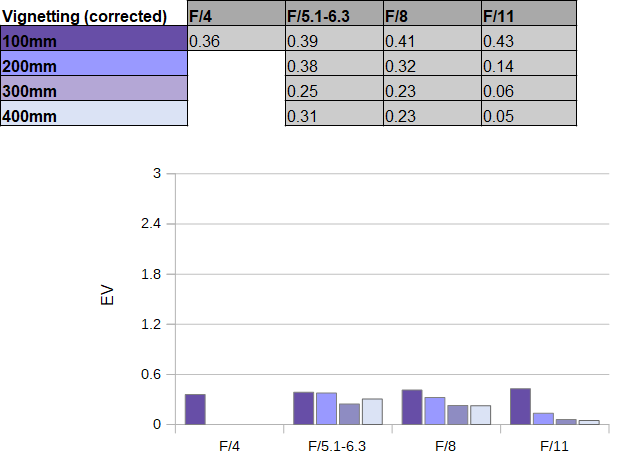|
Leica DG Vario-Elmar 100-400mm f/4-6.3 ASPH Power OIS - Review / Test Report - Analysis |
|
Lens Reviews -
(Micro-)Four-Thirds
|
|
Page 2 of 3

Distortion
Micro-Four-Thirds cameras are using an auto-correction mechanism for image distortions thus there is nothing to worry about in this respect.
When looking into the RAW data, you can still determine the native distortion characteristic of the Leica lens. There are only slight pincushion distortions across the zoom range so the auto-correction doesn't have to be overly aggressive in the first place.
Vignetting
Vignetting is another aspect that is usually corrected under the hood thus the issue is basically negligible from an end-user perspective.
 If you choose to disable auto-correction, you will spot a more pronounced vignetting at fully open aperture but it's still nowhere close to what you'd get on a full format lens. Stopping down by about 1 f-stop resolves the issue by most standards.
If you choose to disable auto-correction, you will spot a more pronounced vignetting at fully open aperture but it's still nowhere close to what you'd get on a full format lens. Stopping down by about 1 f-stop resolves the issue by most standards.

MTF (resolution)
The Leica DG Vario-Elmar 100-400mm f/4-6.3 ASPH Power OIS is a diffraction-limited lens on Micro-Four-Thirds cameras - meaning that the highest resolution is achieved at maximum aperture (typically an aperture around f/2.8 has the highest resolution potential in this system). Even so, the lab results are quite impressive. The center performance is excellent between 100mm and 300mm till about f/8. The outer image field is very good. At 400mm there's a slight drop in quality at f/6.3 but there is still no reason to complain here. Stopping down a little may give you a tad more contrast here. Expect softer results from f/11 onwards ... but then that's rarely a use case. Please note that these results reflect optimal conditions. In real life, you will probably struggle to come close at the extreme tele end due to the inevitable jittering and air diffusion.
The field curvature is very low. The centering quality of the tested sample was very good.
Please note that the MTF results are not directly comparable across the different systems!
Below is a simplified summary of the formal findings. The chart shows line widths per picture height (LW/PH) which can be taken as a measure for sharpness.
If you want to know more about the MTF50 figures you may check out the corresponding Imatest Explanations

Chromatic Aberrations (CAs)
Lateral CAs (colors shadows at the image borders) are very well controlled and usually not an issue with a maximum width of 0.6px at the image borders.

Bokeh
The Leica DG Vario-Elmar 100-400mm f/4-6.3 ASPH Power OIS is a slow lens. However, even so, you can achieve a fairly decent shallow depth-of-field because you can "get close" to your main subject in terms of object magnification. Extreme tele zoom lenses tend to struggle with the quality of the bokeh. i.e. a distinctive outlining of out-of-focus highlights is a frequent issue. As you can see below, the Leica lens is not immune to an "onion-like" substructure within the highlight discs but it's comparatively moderate for a lens in this class.
 As usual, the highlight discs deteriorate towards the image borders/corners as shown below. Stopping down reduces this (vignetting-)effect.
The general rendition of out-of-focus areas is very smooth in the image foreground (show to the right below). The background bokeh is quite good as well but high contrasts are maintained so the result isn't as smooth.
As usual, the highlight discs deteriorate towards the image borders/corners as shown below. Stopping down reduces this (vignetting-)effect.
The general rendition of out-of-focus areas is very smooth in the image foreground (show to the right below). The background bokeh is quite good as well but high contrasts are maintained so the result isn't as smooth.

|